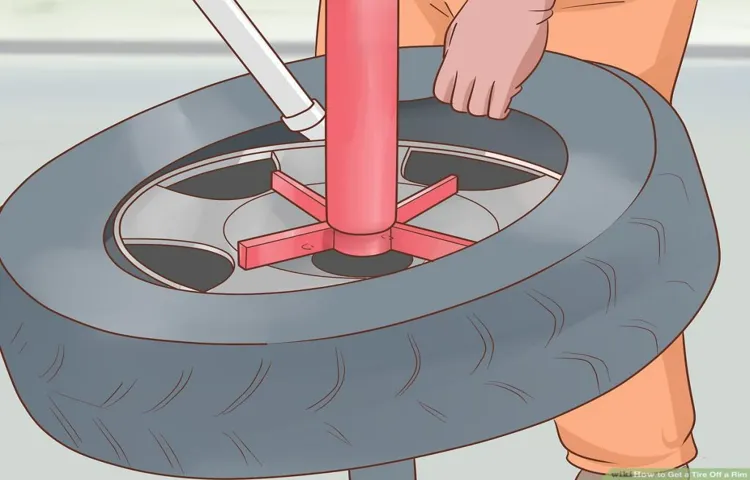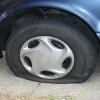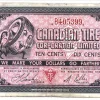Have you ever been in a situation where your car won’t move even though you stepped on the gas as hard as you can? A stuck tire is one of the most frustrating things a driver can experience. Imagine being in a hurry to get to work, but your car is stuck, causing you to be late. Understanding the common causes of a stuck tire will not only save you time and money, but also prevent you from future stress and potential danger.
In this blog, we will discuss the reasons behind a stuck tire, from muddy roads to loose or broken parts. Keep reading to learn more about why your tire is stuck.
Table of Contents
Wheel Nuts Are Too Tight
Are you having trouble getting your tire off? One common issue could be that the wheel nuts are too tight. Over time, dirt and debris can build up around the wheel nuts, making them harder to turn. If you’re not using the correct tools to remove the nut, this can make the process even more difficult.
It’s important to use a proper lug wrench to remove the wheel nuts and not to force them off with other tools. Additionally, if you’ve recently had your tires changed or serviced, the mechanic may have tightened the wheel nuts too much with a power tool. In this case, it’s best to bring your car back to the mechanic and have them loosen the nuts with the proper tools to avoid damaging the wheels or causing further issues.
Remember, it’s important to ensure your wheels are properly secured, but it’s equally essential not to over-tighten the nuts, resulting in difficulty taking them off.
Over-Torquing
Over-torquing can be a serious problem when it comes to your vehicle’s wheel nuts. When the nuts are tightened too much, it can cause an array of issues, including stripped threads, warped rotors, damaged wheel studs, and even complete wheel detachment. So, why do people over-torque their wheel nuts? The answer is simple – they want to ensure the wheels don’t come loose while driving.
However, this may be a catastrophic mistake. Instead of tightening the nuts harder, it’s crucial to follow the recommended torque specification provided by the manufacturer. This is the best way to ensure your vehicle’s safety and avoid any potential damages.
Remember, over-tightening is just as bad as under-tightening. By following the manufacturer’s recommended torque specification, you can keep your wheels tight enough to prevent them from coming off, but not so tight that they cause damage. So, it’s always better to play it safe than sorry and follow the guidelines recommended by the manufacturer to keep your vehicle safe.
Corrosion and Rust
Corrosion and Rust If you’ve ever struggled to remove tight wheel nuts, you’re not alone. It’s common for mechanics to overtighten wheel nuts, causing them to be difficult to remove. However, leaving them too tight can result in damage to the nuts and potentially lead to corrosion and rust.
Corrosion and rust occur when metal is exposed to moisture and oxygen. This can happen when wheel nuts are overtightened and not properly lubricated, causing friction that heats and damages the metal. The resulting rust and corrosion can weaken the metal, making it more susceptible to breakage.
To prevent corrosion and rust on your wheel nuts, it’s important to ensure they are properly lubricated and tightened to the manufacturer’s specifications. Regular maintenance and upkeep can also help prevent rust and corrosion from forming, as well as inspecting the nuts for signs of damage or wear. If you’re struggling to remove tight wheel nuts, it’s best to seek the assistance of a professional mechanic.
Attempting to remove overtightened nuts can cause further damage and put you at risk of injury. With proper care and attention, you can prevent corrosion and rust on your wheel nuts and keep your vehicle running safely and smoothly.
Brake Caliper Is Stuck
If you are experiencing difficulty removing a tire from your vehicle, it could be due to a stuck brake caliper. A brake caliper is an essential component of a disc brake system that helps slow down your car. When it gets stuck, it can cause your tire to seize up, making it difficult to remove.
This problem can be caused by a variety of factors, such as worn out brake pads, corroded brake lines, or a malfunctioning ABS system. It’s important to get it checked out by a mechanic to prevent any further damage to your vehicle. Ignoring this issue can lead to more significant problems down the road and can put you and your vehicle in harm’s way.
So, if you’re wondering, “why is my tire not coming off?” the answer could be a stuck brake caliper.
Worn Brake Pads
When your brakes start squeaking or feeling less responsive, it could be due to worn brake pads. But another potential culprit is a stuck brake caliper. The brake caliper is responsible for holding the brake pads in place and applying pressure to stop the vehicle.
When it gets stuck, the brake pads may not fully release, causing them to rub against the rotor even when you’re not applying the brakes. This can cause excessive wear on the pads and rotor, leading to costly repairs down the line. To prevent this issue, it’s important to have your brakes regularly inspected and maintained by a professional.
If you notice any unusual sounds or sensations while braking, don’t hesitate to get it checked out. By fixing any issues early on, you can save yourself time and money in the long run.
Faulty Brake System
If you’ve ever dealt with a faulty brake system, you know how scary it can be to feel like you’re not in control of your vehicle. One common issue is a brake caliper that’s stuck, which prevents the brake pads from releasing properly and can cause your brakes to constantly drag. This can lead to uneven wear on your brake pads, decreased fuel efficiency, and even a dangerous loss of control if left unchecked.
The good news is that the solution is generally a relatively simple one — your mechanic can inspect your brake system to identify the issue, and replace any necessary parts to ensure that your brakes are working properly once again. Don’t gamble with your safety — if you suspect that your brake system is having issues, take your vehicle in for a thorough inspection as soon as possible.
Damaged Lug Nuts or Bolt Studs
If you’re having trouble removing a tire, one possible culprit is damaged lug nuts or bolt studs. Over time, lug nuts can become corroded or stripped, making them difficult to remove even with the proper tools. Similarly, bolt studs can become damaged or stripped, which can make it impossible to remove the tire altogether.
If you suspect that this is the problem, it’s important to address it as soon as possible. Attempting to force a tire off if the lug nuts or bolt studs are damaged could result in even more damage, which will only make the process more difficult. If you’re not confident in your ability to remove a damaged lug nut or bolt stud, it’s always a good idea to seek professional help.
A mechanic can remove the damaged part with specialized tools and replace it with a new one, ensuring that your tire can be removed safely and easily in the future. By addressing the problem early on, you can avoid the frustration of a stuck tire and ensure that your car is safe and reliable.
Stripped Threads
When it comes to maintaining your vehicle, one issue that can occur is stripped threads on lug nuts or bolt studs. This happens when the threads on these parts become worn down or damaged, making it difficult to properly secure the wheel. It’s important to avoid driving with stripped threads as it can lead to dangerous situations such as a loose wheel or even a complete detachment.
To prevent this issue, it’s important to properly torque the lug nuts or bolts when changing a tire and to regularly inspect them for any signs of wear or damage. If you do notice stripped threads, it’s best to have them repaired or replaced by a professional mechanic. Don’t take any risks when it comes to the safety of your vehicle and those on the road with you.
Deformed Threads
Deformed threads on lug nuts or bolt studs can be a common problem for many drivers. This can occur due to a variety of reasons such as overtightening, cross-threading, or corrosion. When the threads on lug nuts or bolts become deformed, it can lead to many issues including difficulty in removing the nuts or bolts, improper wheel alignment, and wheel instability.
It is important for drivers to keep an eye out for any signs of damaged lug nuts or bolt studs, such as visible signs of deformity or difficulty in tightening or loosening the nuts or bolts. The best way to prevent deformed threads is to ensure that lug nuts or bolts are always properly tightened to manufacturer specifications and to inspect them regularly for signs of damage or wear. If you do encounter damaged threads, it is important to have them repaired or replaced as soon as possible to avoid further damage and ensure safe driving.
How to Remove a Stuck Tire
One of the most frustrating things for a car owner is trying to remove a stuck tire. You may have changed tires many times before, but for some reason, this time, the tire just won’t budge. There are several reasons why a tire may be difficult to remove.
The most common cause is corrosion. Over time, the lug nuts can become corroded, making them difficult to turn. The rust can also cause the wheel to fuse to the hub, making it almost impossible to remove.
To fix this issue, apply some penetrating oil to the lug nuts and let it sit for a few minutes. This should loosen the rust and make it easier to remove the tire. Another culprit could be the tire itself.
If the tire has been on the car for a long time, it may have flattened and adhered to the hub. In this situation, try gently rocking the tire back and forth until it breaks free. Whatever the cause, removing a stuck tire can be frustrating, but don’t give up.
With a little patience and elbow grease, you’ll get that tire off eventually.
Using a Lug Wrench and Lubricant
Removing a stuck tire can be a frustrating task, but with the right tools and techniques, it can be done quickly and easily. One of the most essential tools you’ll need is a lug wrench, which helps to loosen the lug nuts that hold the tire in place. When using the lug wrench, it’s important to apply even pressure and turn it in a clockwise motion.
If the lug nuts are particularly tight, you may want to use a lubricant, such as WD-40, to help loosen them up. Be sure to use a small amount of lubricant and avoid getting it on the brake pads or rotors. With a little patience and persistence, you should be able to remove the stuck tire and get back on the road in no time.
Just remember to always stay safe and take your time when working on your vehicle.
Heat and Impact Methods
Removing a stuck tire can be a frustrating task, but there are several heat and impact methods that can help make the job easier. One popular method is using a heat gun or blowtorch to heat up the rim around the tire, causing it to expand and loosen from the hub. It’s important to only heat the rim and not the tire itself, as this could cause damage or even a blowout.
Another option is using a rubber mallet and hitting the tire around the rim, working your way around until it loosens. If that doesn’t work, a tire iron or pry bar can be used to leverage the tire off. No matter which method you choose, it’s important to take the proper safety precautions and to be patient; rushing or using too much force could cause further damage.
With a little effort and time, you’ll be able to remove that stuck tire and get back on the road.
When to Seek Professional Help
If you’re struggling to remove a tire from your vehicle, you may be tempted to keep trying until it finally comes off. However, it’s important to know when to seek professional help. One reason your tire may not be coming off could be due to a stuck lug nut.
In this case, using excessive force could damage the tire or even cause injury. Another reason could be that the wheel is seized onto the hub, which could require specialized tools and expertise to safely remove. In either case, it’s best to consult with a professional mechanic who can properly diagnose and fix the issue.
Don’t put yourself or your vehicle at risk by attempting to forcefully remove a tire on your own.
Conclusion
Well, the answer to why your tire is not coming off is rather simple. It’s because it’s tired of being constantly replaced and is holding on for dear life! But in all seriousness, it could be due to a number of factors such as worn out lug nuts, rust and corrosion, or even an improperly seated tire. So, it’s best to take care of your tires with regular maintenance and avoid letting them become too attached to your vehicle.
“
FAQs
Why won’t my tire come off even after removing all the lug nuts?
It could be due to rust build-up, which can make the tire stick to the hub. You can try hitting the tire with a rubber mallet or using rust dissolver spray to help loosen it.
What should I do if the tire is still stuck even after using a rubber mallet and rust dissolver spray?
If the tire is still stuck, try using a jack to lift the vehicle and then try hitting the tire once again with the rubber mallet. Make sure to add some lubrication to the hub to help loosen the tire.
Could a stripped lug nut cause the tire to not come off?
Yes, a stripped lug nut can cause the tire to not come off. In this case, you will need to use a lug nut extractor to remove the stripped nut.
How can I prevent my tire from getting stuck on the hub?
You can prevent your tire from getting stuck by regularly cleaning and lubricating the hub. You can also use anti-seize lubricant on the lug nuts to prevent rust build-up.
Can a tire be damaged if it’s stuck on the hub for too long?
Yes, a tire can get damaged if it’s stuck on the hub for too long. The weight of the vehicle can cause flat spots on the tire, which can lead to vibration and other issues when driving.
Is it safe to drive with a stuck tire?
It is not safe to drive with a stuck tire. If the tire is not properly secured to the hub, it can cause a dangerous situation while driving.
Should I seek professional help if I cannot get the tire off?
Yes, if you’re unable to get the tire off, seek professional help. A mechanic will have the necessary tools and expertise to safely remove the tire without causing any damage to the vehicle.



